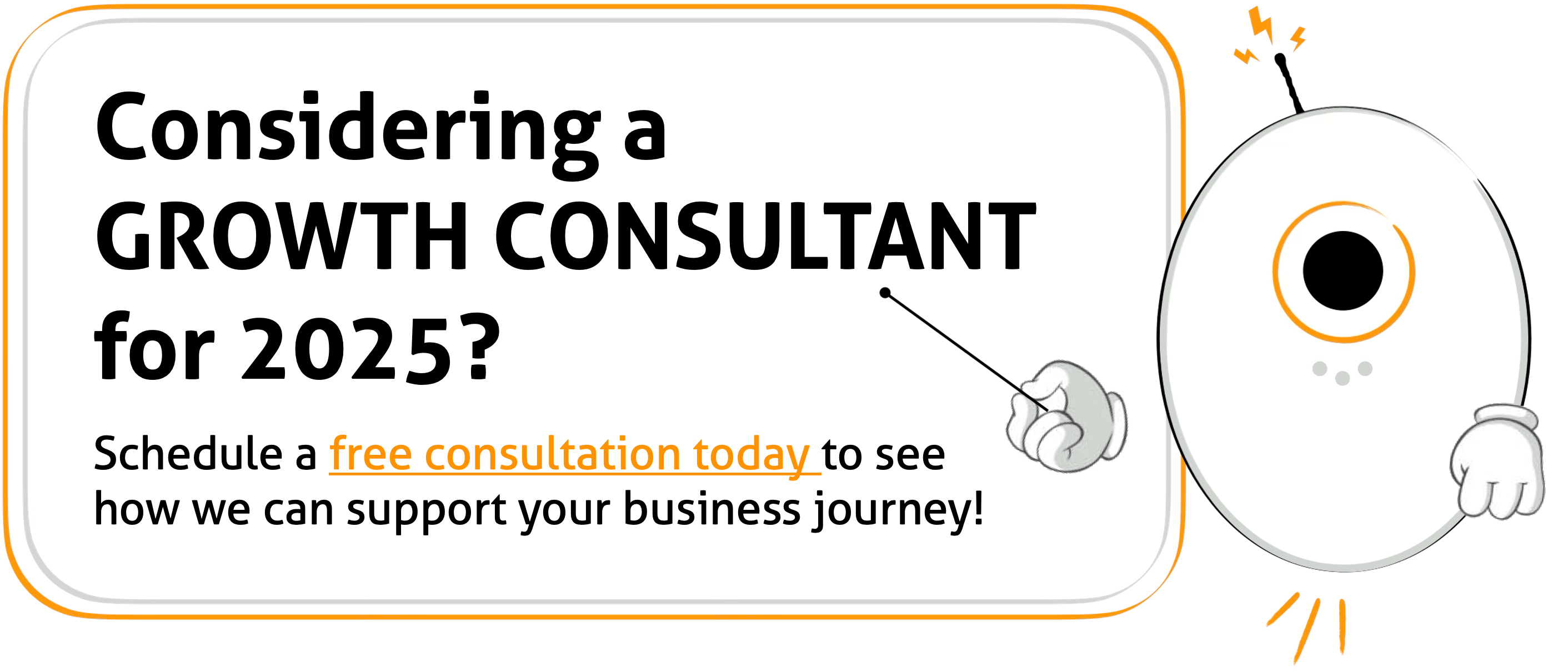
In the world of business, growth is a journey, not a destination. For small and medium-sized businesses (SMBs), crafting and nurturing a growth story is more than just expanding revenue; it’s about building resilience, market position, and sustained value for customers. So how can marketers, especially strategic marketing consultants, play a pivotal role in guiding SMBs through this journey?
This blog explores how marketers can act as strategic partners in helping SMBs craft a meaningful growth story. We’ll delve into what a growth story really means, share real-world examples, and provide insights on actionable strategies that a strategic marketing consultant might implement to achieve that success. Plus, we’ll lay the groundwork for a two-part blog series coming in early 2025 that will dive deeper into these concepts.
1. Understanding the Growth Story for SMBs
Defining a Growth Story
A growth story is the narrative that a company builds around its evolution, achievements, and potential for future success. For an SMB, a growth story is more than just figures and market share—it’s about showing why they matter, how they meet customer needs, and how they plan to keep improving.
What Makes a Compelling Growth Story?
A growth story should be:
- Customer-Centric: Built around solving genuine customer challenges and adding value.
- Data-Driven: Leveraging metrics and analytics to highlight real progress.
- Future-Focused: Offering a vision of ongoing growth, backed by actionable plans.
- Human: Resonating on an emotional level by connecting with customers, investors, and employees alike.
Examples of SMB Growth Stories
Here are three Indian SMBs that achieved substantial growth through strategic positioning and marketing tailored to meet local needs:
Chai Point: Bringing India’s Favorite Beverage to the Corporate World
- Strategy: Chai Point recognized the ubiquitous demand for high-quality tea in India and aimed to make chai accessible and consistent for office-goers. They created a blend of physical retail stores, delivery options, and an automated vending solution, “Chai @ Work,” for office spaces.
- Tactics: Chai Point differentiated itself by focusing on quality ingredients and a tech-enabled experience. They introduced online ordering, a subscription-based model, and contactless smart vending machines in corporate offices, making them a go-to for businesses wanting chai in the workplace.
- Result: Starting in 2010, Chai Point expanded to over 100 stores across major cities and became a favorite in the corporate segment. Their integration of tech, brand identity around tea, and quality focus turned them into a market leader in India’s organized chai market.
Lenskart: Revolutionizing the Eyewear Market in Tier-2 and Tier-3 Cities
- Strategy: Lenskart aimed to make eyewear more affordable and accessible, especially for consumers in Tier-2 and Tier-3 cities where quality eyecare options were limited. They offered both online and offline services, allowing customers to access eye tests, prescription lenses, and fashionable frames at reasonable prices.
- Tactics: They used a hybrid model of online and offline stores, offering a virtual try-on feature and free home eye checkups. They also offered financing options, discounts, and customized products to make eyewear accessible to a wide audience.
- Result: Since its founding in 2010, Lenskart has grown exponentially, becoming a unicorn in 2020. With over 1,000 stores across India and Southeast Asia, Lenskart effectively penetrated regional markets and helped make quality eyewear accessible to millions.
Zomato: Becoming India’s Go-To Food Delivery Platform
- Strategy: Zomato started as a restaurant discovery platform and expanded into food delivery, capitalizing on India’s growing appetite for on-demand food services. By building a vast delivery network, it made dining out an at-home experience for urban consumers and introduced services in smaller cities over time.
- Tactics: Zomato leveraged a highly localized approach, understanding the tastes and preferences of different cities and regions. They used aggressive marketing campaigns, subscription models (Zomato Gold), and partnerships with restaurants to grow their user base. Additionally, they expanded into grocery and essentials delivery during the COVID-19 pandemic, adapting to changing consumer needs.
- Result: Zomato scaled to over 500 cities in India and became one of the largest food delivery platforms in the country. They went public in 2021, marking a historic IPO in the Indian startup ecosystem and solidifying their place as a leader in the food tech sector.
These Indian SMBs each identified a unique opportunity in the market, utilized innovative business models, and engaged in strategic marketing to achieve significant growth and create strong brand identities in highly competitive sectors.
These stories show SMBs taking specific actions to achieve growth milestones, which are essential to their journey. Strategic marketing consultants work behind the scenes, providing insights and guiding these businesses to make data-driven, customer-focused, and scalable decisions that align with their growth narrative.
2. Why SMBs Need Strategic Marketing Consulting for Growth
SMBs are often strapped for time, resources, and marketing expertise. A strategic marketing consultant acts as a growth partner, providing a roadmap and the expertise to avoid common pitfalls.
How Marketers Drive Growth for SMBs: Key Areas of Focus
- Market Research & Customer Insights: Understanding customer preferences, competitive positioning, and market gaps.
- Growth-Driven Content Strategy: Developing a mix of content that attracts, nurtures, and converts leads.
- Data Analytics & Performance Tracking: Tracking KPIs and analyzing data to refine marketing and sales strategies.
- Digital Transformation: Implementing and optimizing digital tools for streamlined marketing, sales, and customer service.
3. The Pillars of an SMB Growth Story
Pillar 1: Identifying the Target Market and Building a Customer-Centric Brand
Knowing and defining the target market is the foundation of any growth story. This involves:
- Conducting In-Depth Customer Research: Understanding pain points, needs, and buying behavior.
- Developing a Unique Value Proposition (UVP): Standing out by offering a clear and compelling reason for customers to choose you.
- Creating Customer Personas: Visualizing who your ideal customers are and how they make decisions.
Example: A small cloud services firm focused on healthcare practices can work with a strategic marketing consultant to refine its UVP, targeting small clinics with a HIPAA-compliant solution. The consultant helps the firm develop messaging that resonates with healthcare providers’ unique needs, helping to differentiate it from general cloud solutions.
Pillar 2: Building Trust with Compelling Content and Storytelling
Content is the heart of any growth story. To attract and engage customers, SMBs need a consistent, thoughtful content strategy that aligns with their values and goals.
- Educational Content: Blogs, whitepapers, and webinars that address customer questions and demonstrate expertise.
- Emotional Connection: Sharing customer testimonials and stories that showcase the brand’s impact.
- Engagement Tactics: Social media, email newsletters, and videos that encourage interaction.
Example: An SMB in eco-friendly packaging can share success stories of how their products reduce environmental impact, attracting like-minded customers.
Pillar 3: Utilizing Analytics for Growth and Optimization
Without data, it’s impossible to measure growth accurately. SMBs need robust analytics to make informed decisions and pivot quickly if needed.
- Setting Clear KPIs: Sales, customer retention, and brand awareness metrics that align with the growth story.
- Using Customer Feedback for Improvement: Regularly gathering feedback to refine products, services, and customer experiences.
- Regular Performance Reviews: Working with consultants to analyze what’s working, what isn’t, and where to invest resources.
Pillar 4: Amplifying Reach with Digital Marketing
Digital marketing allows SMBs to extend their reach and tell their story on a larger scale. Key tactics include:
- Social Media Marketing: Engaging content and paid ads to connect with a broader audience.
- SEO and Content Marketing: Increasing organic visibility and driving website traffic.
- Email Marketing & Automation: Keeping prospects engaged with valuable content and nurturing leads toward conversion.
4. Real-World Examples: Growth Stories Shaped by Strategic Marketing
Case Study 1: Retail SMB’s Digital Transformation Journey
A local retail business struggled with stagnant growth. A strategic marketing consulting firm helped them:
– Develop an online presence by building an e-commerce website.
– Implement a social media and email strategy to engage local customers.
– Use data analytics to identify the best-selling products and optimize stock management.
Outcome: Within six months, the business saw a 35% increase in monthly revenue and established itself as a local leader in its niche.
Case Study 2: B2B Service SMB Growing Through Account-Based Marketing
A B2B service company partnered with a consultant to target high-value accounts.
– They identified specific industries and created customized marketing campaigns.
– Used LinkedIn ads and personalized email outreach to engage decision-makers.
– Aligned their sales and marketing teams to ensure a seamless experience for leads.
Outcome: The company closed six major contracts, driving a 25% increase in annual revenue.
5. Building a Growth Story Roadmap: An Action Plan for SMBs
To help SMBs build and sustain their growth story, here’s an actionable plan that strategic consultants might recommend.
Phase 1: Foundation
– Define Goals: Set specific growth goals (e.g., revenue increase, customer acquisition).
– Conduct Market Research: Identify target segments and understand customer needs.
– Establish Brand Identity: Develop messaging and a UVP.
Phase 2: Implementation
– Develop Content Strategy: Create a calendar with a mix of blogs, social posts, and email campaigns.
– Launch Digital Campaigns: Use social media, PPC, and SEO to increase visibility.
– Implement Lead Nurturing: Set up automated workflows to nurture leads through email and retargeting.
Phase 3: Optimization and Scaling
– Measure KPIs: Track performance with analytics and make data-driven adjustments.
– Refine Strategies: Use customer feedback to improve product offerings and customer experiences.
– Invest in High-ROI Channels: Double down on what’s working and scale up successful campaigns.
6. The Consultant’s Role in Crafting the SMB Growth Story
A strategic marketing consultant provides more than guidance; they are partners in the growth journey. Here’s how:
– Tailored Strategy: Consultants help SMBs craft strategies unique to their industry, goals, and resources.
– Objective Analysis: Providing data-driven insights and honest feedback for better decision-making.
– Scalable Solutions: Implementing solutions that can grow as the business expands.
7. The Path Ahead: Building on Your Growth Story
This blog lays the groundwork for two upcoming articles set to be released in early 2025:
– Part 2: Accelerating SMB Growth with Data and Technology – A deeper dive into data analytics, CRM, and marketing automation for scaling.
– Part 3: Future-Proofing Your SMB Growth Strategy – Insights into staying resilient and adaptable in a competitive market.
Stay tuned as we continue to explore how SMBs can create growth stories that stand the test of time.
Share This Story, Choose Your Platform!
FAQs
Marinoid has a different grammatical meaning. We coined it from two words viz Marketing + Droids. A futuristic approach to marketing. Our mascot ‘Noidy’ is designed and inspired by the movie, WALLE and shares the same emotional quotient.
You will get a call from us within 24 hours or when you have scheduled a call. First meeting focuses on understanding your business problem and/or marketing request. We will brainstorm the need and discuss how to approach it. If you like the approach, we will discuss the commercials and kickstart the journey.
Digital Marketing is not magic. It is a science and art. Besides, there are various factors which decide ‘success’. Treat marketing as an investment centre rather than a cost centre. Understand and brainstorm as much as possible before committing to the plan.
A wise man once said – “If you throw peanuts, you will only attract monkeys!” At Marinoid, we focus on helping you achieve GTM first rather than focusing on our profits – so don’t worry we will help you regardless.
In simple terms, your website – your most critical asset. Focus most of your efforts on making this asset robust, scalable and simple. It should be your best replacement on the web and all your efforts should be circled around this asset.
Yes, there is an hourly charge for consultation. Check our pricing page or drop us a note and we will tell you the details.

Some of our Recent Posts:
Your B2B Marketing Isn’t Broken — It’s Just Operating on 2018 Logic in a 2025 Reality
Let’s set the scene. You're running a B2B SMB in 2025. You've got a great product, a tight-knit team, and a marketing funnel that should be working harder than [...]
Beyond Buzzwords: How SMBs Can Transform Virtual Influencers into AI-Driven Problem-Solvers
Welcome to the Future of SMB Marketing Picture this: you run a thriving SMB offering IT services or products, and your customer pipeline is growing fast. Great news! But [...]
The Future of Attraction: Inbound Marketing in 2025—A Strategic Guide for SMBs
As we get ready for 2025, the way we attract customers is evolving rapidly, driven by the fusion of advanced technology, shifting consumer expectations, and innovative inbound strategies. For [...]
How AI and Personalization are Revolutionizing Customer Engagement.
A Roadmap for SMBs in 2025 Imagine knowing each of your customers so well that you can tailor every interaction, every message, every offer just for them. It sounds like [...]




